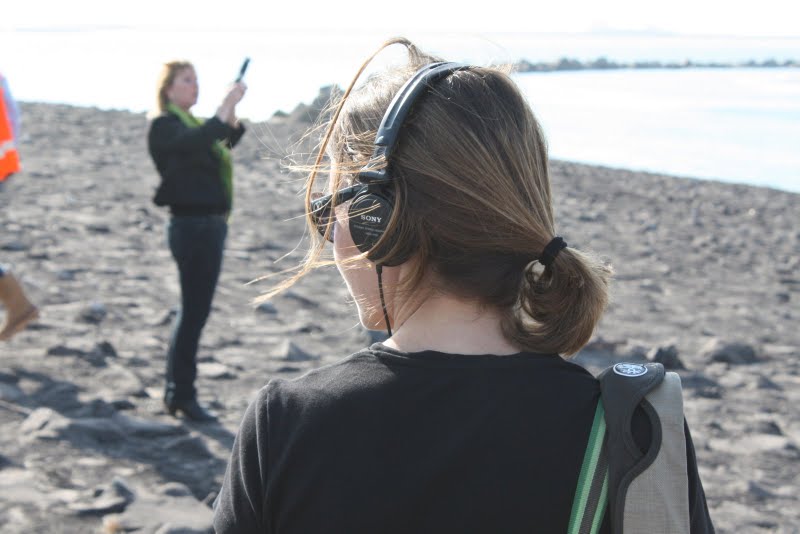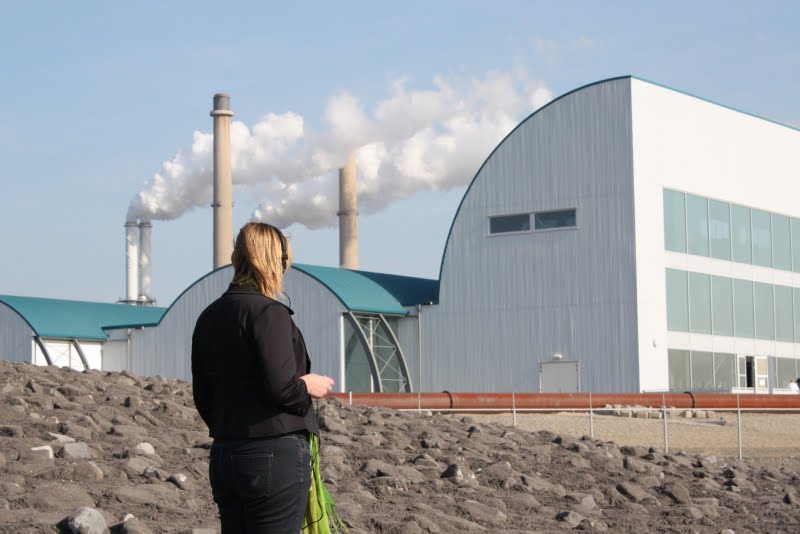“Postpetrolistic Internationale” choir performance by Christina Hemauer & Roman Keller on Maasvlakte, Rotterdam, 8 November 2009. Commissioned and produced by the Port of Rotterdam as part of “Portscapes”, with support and advice from SKOR and curated by Latitudes. Courtesy: SKOR / Photo: Paloma Polo.
Cover of “LAND, ART: A Cultural Ecology Handbook” edited by Max Andrews, and coordinated by Mariana Cánepa Luna. Published and commissioned by the Royal Society of Art in partnership with the Arts Council England, 2006. Photo: Robert Justamente.
Spread of UOVO magazine #14, a 500-page issue + two CDs guest edited by Latitudes, 2007. Photo: Alexis Zavialoff.
Pages of Lara Almarcegui's first monograph “Lara Almarcegui. Projects 1995–2010” (Archive Books, 2011) covering 15 years of her artistic practice, with commissioned texts by Cuauhtémoc Medina and Lars Bang Larsen, and an introduction by Latitudes. Photo: Latitudes.

View of “Ocells perduts” (Stray Birds) (2021) by Laia Estruch in the exhibition “Panorama 21. Apunts per a un incendi dels ulls” (“Panorama 21: Notes for an Eye Fire”), MACBA Museu d'Art Contemporani de Barcelona, 22 October 2021–27 February 2022. Curated by Hiuwai Chu and Latitudes. Produced by MACBA Museu d'Art Contemporani de Barcelona with the support of PUBLICS, Helsinki. Research supported by a Premis Ciutat de Barcelona 2020 grant from the Barcelona City Council. Photo: Roberto Ruiz.
In terms of related public-realm commissions, we worked with Danish artist Tue Greenfort for The Royal Society of Arts’ pioneering Arts & Ecology programme (2005–2008) and curated ten public art projects around Europe’s largest seaport, the Port of Rotterdam (“Portscapes” in 2009–2010). We have also organised thematic curatorial residencies around geological agency (“Geologic Time”, Banff Centre, 2017) and a touring film programme on the legacy of Land Art (“A Stake in the Mud a Hole in the Reel”, 2008–2009).
Last but not least, since 2008 we have been custodians of the website of RAF/Reduce Art Flights, a reference resource about the campaign initiated by the late Gustav Metzger (1926–2017).
RAF/Reduce Art Flights website reduceartflights.lttds.org
Latitudes’ environmental impact is small, yet we acknowledge that the largest impact comes from flights and the disproportionate mobility practices of the sector we work in. We believe that art and culture have a role to play in bringing about ambitious change, applying best practices and setting a positive example to position the climate crisis at the centre of the political and social debate.
In January 2023 we became individual members of the Gallery Climate Coalition (GCC) and began to work with colleagues to set up the Spanish volunteer team, GCC España, that meets regularly to track progress on environmental targets and actions.
Making of Jan Dibbets’ film “6 Hours Tide Object with Correction of Perspective” (1969–2009). Commissioned and produced by the Port of Rotterdam as part of “Portscapes”, with support and advice from SKOR, curated by Latitudes. Documentation included in the multi-part publication box “Portscapes” designed by Ben Laloua / Didier Pascal, launched with the opening of the exhibition “Portscapes” at the Museum Boijmans van Beuningen in Rotterdam, 2010. Photo: Latitudes.
Editors of Rotterdam-based magazine Fucking Good Art were ‘embedded’ in the port's Yangtzehaven for a month in the summer of 2009 from where they produced ‘Portscapes_ON AIR Station Maasvlakte’, a series of audio walks, field recordings and conversations with guests from different disciplines for the “Portscapes” website. Photo courtesy: FGA.
We will
measure and publish our carbon footprint every year to comply with the
GCC targets and commitments of reducing carbon emissions by 50% by 2030 (when compared to a 2019 baseline). Rather than purchasing carbon offsets, and following GCC guidelines on
this matter, we are also setting aside a
fund (€50 per tonne of emitted CO2 per year) to be spent on low-carbon purchasing options that would otherwise be unaffordable. Our intention is to eliminate unwarranted air travel, and we do not take flights when there is an alternative rail or sea route that takes less than 7 hours. The latter policy follows one adopted by the
Ajuntament de Barcelona (the City Council) in 2020.
Latitudes requests external collaborators opt for train or alternative low-carbon transit and freight options in line with GCC’s guidelines (as well as Gustav Metzger’s RAF/Reduce Art Flights campaign) and this is reflected in work contracts. We hope to lead by example in implementing a sustainability strategy in the planning of exhibitions from an early stage, and whenever curating projects we always try to build the minimum necessary temporary architecture and ensure that any exhibition-related production is entirely locally tuned. We ask that collaborators use no plastic or other single-use materials when transporting works or for events.
Hike with “Geologic Time” participants to Stanley Glacier in Kootenay National Park, as part of the residency programme curated by Latitudes at the Banff Centre for Arts and Creativity, Banff, Canada, 11 September–6 October 2017. Photo: Latitudes.
Latitudes’ website runs on sustainable energy. According to websitecarbon.com (see stats below), LTTDS.org produces 16.76kg of C02 equivalent per year, roughly the amount of carbon that one tree would absorb in the same time, and it consumes 44kWh of energy (equivalent to 280km in an electric car).
In our personal lives, we prioritise the 5 Rs: Refusing, Reducing, Reusing, Repurposing and Recycling. We do not own a car and use public transport networks. Other practical actions we undertake include periodically donating household or clothing items to charity organisations that offer support to vulnerable communities in our neighbourhood (including Fundació Roure and El Trampolí). And last but not least, since 2013 Latitudes banks with an ethical bank which finances initiatives that contribute to ecological, social and cultural change.
Left-sided entrance to the exhibition “4.543 billion. The Matter of Matter” with the participation of over thirty artists and the presentation of over a hundred works, CAPC musée d’art contemporain de Bordeaux, June 2017–January 2018. Photos: Latitudes / RK.
RELATED CONTENT:
- Gallery Climate Coalition (GCC) en el Estado español, 25 January 2023
- Latitudes’ essay “Un suelo para las historias del arte del futuro” [Soil for Future Art Histories] in TBA21’s catalogue “Futuros Abundantes / Abundant Futures”, 22 Jan 2023
- “‘Minor’ Ornithologies” podcast conducted by Max Andrews of Latitudes for TBA21 on st_age, 27 Sep 2022
- Cover Story, September 2021: Erratic behaviour—Latitudes in conversation with Jorge Satorre, 31 Aug 2021
- 18 marzo 2021, 18:30h: Mesa redonda “Transformación geológica y construcción artificial” con Lara Almarcegui y Juan Guardiola, 8 Mar 2021
- Lead Faculty, Geologic Time, Banff International Curatorial Institute, Visual + Digital Arts Department, Banff Centre for Arts and Creativity, Banff, Canada, 11 September–6 October 2017
- Group exhibition, “4.543 billion. The matter of matter”, CAPC musée d’art contemporain Bordeaux, France, 29 June 2017–7 January 2018
- Editors, “Lara Almarcegui. Projects 1995–2010”, Archive Books, 2011
- Solo exhibition, “Christina Hemauer & Roman Keller: United Alternative Energies”, Kunsthal Aarhus, Århus, Denmark, 22 January–3 April 2011
- Public realm commissions, Portscapes, Port of Rotterdam, the Netherlands, throughout 2009
- Custodians, Reduce Art Flights (RAF) website (2008–ongoing)
- Touring film programme, “A Stake in the Mud, A Hole in the Reel. Land Art’s Expanded Field 1968–2008”, Museo Tamayo, Mexico City, and other venues, April–October 2008
- Group exhibition “Greenwashing. Perils, Promises and Perplexities”, Fondazione Sandretto Re Rebaudengo, Torino, February–May 2008
- Convenors, “Art, Ecology and the Politics of Change”, 3-day symposium during the Sharjah Biennial 8, 5–7 April 2007
- Editors, “UOVO #14: Ecology, Luxury and Degradation”, 2007
- Editor, “LAND, ART: A Cultural Ecology Handbook” (2006)
- Curator, Tue Greenfort, Arts & Ecology public realm commission in London, 2005–2008













































































































